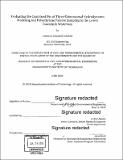Evaluating the combined use of three-dimensional hydrodynamic modeling and polyethylene passive sampling in the Lower Duwamish Waterway
Author(s)
Sobchuk, Catherine Elizabeth
DownloadFull printable version (10.09Mb)
Other Contributors
Massachusetts Institute of Technology. Department of Civil and Environmental Engineering.
Advisor
E. Eric Adams.
Terms of use
Metadata
Show full item recordAbstract
Polyethylene (PE) passive samplers are capable of measuring in-situ, freely dissolved, time-averaged concentration distributions of contaminants in air, surface water, and sediment bed porewater. This sampling technique can be coupled with a three dimensional (3D) hydrodynamic model of a given surface water body to identify where sources contributing to the measured concentration distribution are most likely located and what mass flux is required to produce the measured concentrations. This evaluation was completed for the Lower Duwamish Waterway (LDW), a salt wedge estuary located in Seattle, Washington. The LDW was selected for its idealized conditions (straight channel with relatively uniform cross-section), established 3D hydrodynamic model (Environmental Fluid Dynamics Code [EFDC]), and availability of measured data. Density-driven circulation in the LDW drives saltwater upstream and freshwater downstream, influencing residence times, mixing times, and the resulting concentration distributions of potential sources. The dependence of simulated, unit strength concentration distributions on source location was evaluated by spatially comparing EFDC-simulated sources introduced at various points in the LDW. This determined how far apart potential sources need to be, referred to as a distinguishable distance, to be "resolved" by measured or modeled concentrations at the LDW centerline. East and west bank sources were generally distinguishable within 0.8 miles of introduction; water surface and sediment bed sources were generally distinguishable throughout the LDW; longitudinally distributed sources were distinguishable for 0.4 to 1.1 miles from the source location. PE passive samplers placed at the centerline of the LDW with spacing at or near the distinguishable distance will likely be able to differentiate between various source locations. Inverse model techniques were applied to measured concentration distributions in the water column using numerous cases of potential source locations with distinguishable, unit strength concentration distributions. The resulting mass fluxes ranged from 0.034 mg/s to 0.072 mg/s (average 0.043 mg/s), an order of magnitude higher than known source fluxes (i.e., sediment diffusive flux and air-water exchange flux). Therefore, one or more "missing sources" were determined to exist; based on this evaluation, it is possible the sources originate from the midstream sediment bed, upstream sediment bed, and upstream water surface.
Description
Thesis: M. Eng., Massachusetts Institute of Technology, Department of Civil and Environmental Engineering, 2018. Cataloged from PDF version of thesis. Includes bibliographical references (pages 122-124).
Date issued
2018Department
Massachusetts Institute of Technology. Department of Civil and Environmental EngineeringPublisher
Massachusetts Institute of Technology
Keywords
Civil and Environmental Engineering.